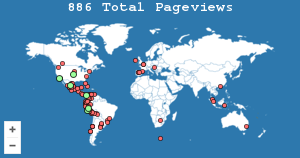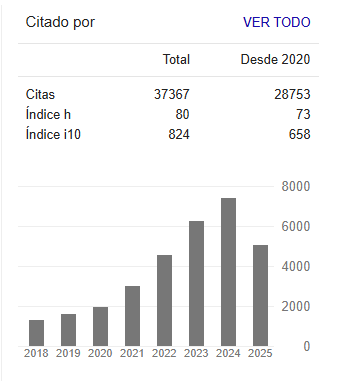Factores de riesgo en accidentes domiciliarios del adulto mayor
Abstract
Se realizó un estudio con el objetivo de poder determinar los factores de riesgo en accidentes domiciliarios en el adulto mayor y sus consecuencias. Se realizó un estudio de enfoque cuantitativo de campo, analítico y transversal. Se eligió una muestra de 150 participantes mayores de 65 años. Se obtuvieron datos muy relevantes el 68% de la muestra corresponde al sexo femenino, mayores de 65 años, casados con hijos, escolaridad primaria; en un 74% se dedican a quehaceres doméstico y jubilados 31%. Las causas de accidente domiciliario fueron por obstáculos en escalera 32% y por irregularidades en el piso 27.3%, y como consecuencia se presentaron caídas con un 34%, contusiones con 24.6%, quemaduras con 14.6%. evidenciándose que estas personas no reciben ningún tipo de capacitación para la prevención de factores de riesgos en el hogar ni tampoco han recibido capacitación para su autocuidado, a pesar de que la mayoría sufre de enfermedades catastróficas como hipertensión arterial (41.3), diabetes (30%), artritis (16%). Osteoporosis (8%). Se puede concluir que se evidenció un alto riesgo en las personas mayores del sexo femenino principalmente por accidentes y entre estos, por las caídas y el nivel de conocimientos sobre accidentes en los adultos mayores y familiares mostró poco conocimiento.References
Alcívar, C., Blanc, G., & Calderón, J. (2018). Aplicación de la ciencia forense en los delitos informáticos en el Ecuador y su punibilidad. Revista espacios.
Alcivar, C., Vargas, V., Calderon, J., Triviño, C., Santillan, S., Soria, R., & Cardenas, L. (2019). El uso de las TIC en el proceso de enseñanza-aprendizaje de los docentes en las Universidades del Ecuador. Revista ESPACIOS, 40(02).
Armitage, J., Baigent, C., Barnes, E., Betteridge, D. J., Blackwell, L., Blazing, M., … Cannon, C. (2019). Efficacy and safety of statin therapy in older people: a meta-analysis of individual participant data from 28 randomised controlled trials. The Lancet, 393(10170), 407–415.
Burke, M. & Walsh, M. (1998). Enfermería gerontológica. Masson.
Calderón-Cisneros, J., Ortiz-Chimbo, K. M., & Alcívar-Trejo, C. (2018). Exploratory factorial analysis as a multivariate method for the validation of academic data in virtual platforms. Revista Lasallista de Investigación, 15(2), 10–19.
Comisión Económica para América Latina y el Caribe (CEPAL) (2018). Envejecimiento, personas mayores y Agenda 2030. https://repositorio.cepal.org/bitstream/handle/11362/44369/1/S1800629_es.pdf
Fernández, M. (2013). Geriátrica y envejecimiento poblacional. Editorial Ciencias Médicas. Cuarta edición.
Gale, C. R., Westbury, L., & Cooper, C. (2018). Social isolation and loneliness as risk factors for the progression of frailty: the English Longitudinal Study of Ageing. Age and Ageing, 47(3), 392–397.
Gutiérrez‐Valencia, M., Izquierdo, M., Cesari, M., Casas‐Herrero, Á., Inzitari, M. & Martínez‐Velilla, N. (2018). The relationship between frailty and polypharmacy in older people: a systematic review. British Journal of Clinical Pharmacology, 84(7), 1432–1444.
Haule, H. J., Sando, T., Kitali, A. E. & Richardson, R. (2019). Investigating proximity of crash locations to aging pedestrian residences. Accident Analysis & Prevention, 122, 215–225.
Hernández, G. (2014). Incidencia de factores de riesgo social en adultos mayores en Municipio Cerro. Centro de Investigaciones sobre: Envejecimiento, Longevidad y Salud. http://www.bvs.sld.cu/revistas/hie/vol39_2_01/hie01201.htm.
Hopewell, S., Adedire, O., Copsey, B. J., Boniface, G. J., Sherrington, C., Clemson, L., … Lamb, S. E. (2018). Multifactorial and multiple component interventions for preventing falls in older people living in the community. Cochrane Database of Systematic Reviews, (7).
Instituto Ecuatoriano de Estadísticas y Censos (INEC). (2010). VII censo de población y VI de vivienda. INEC. www.inec.gob.ec.
Jara, T. (2014). Discapacidad Sensorial: Visión y Oído. http://escuela.med.puc.cl/publ/manualgeriatria/PDF/DiscapacidadSensorial.pdf .
Ley del Adulto Mayor. (2013). Asamblea Nacional Constituyente. Montecristi. Editorial Jurídica Ecuatoriana.
Masot, O., Lavedán, A., Nuin, C., Escobar-Bravo, M. A., Miranda, J., & Botigué, T. (2018). Risk factors associated with dehydration in older people living in nursing homes: Scoping review. International Journal of Nursing Studies, 82, 90–98.
McDonald, E. M., Mack, K., Shields, W. C., Lee, R. P., & Gielen, A. C. (2018). Primary care opportunities to prevent unintentional home injuries: a focus on children and older adults. American Journal of Lifestyle Medicine, 12(2), 96–106.
MedlinePlus. (2016). Enfermedades Neurológicas. New York, Estados Unidos: Biblioteca Nacional de Medicina de los EE.UU. https://www.nlm.nih.gov/medlineplus/spanish/neurologicdiseases.html.
Organización Mundial de la Salud (OMS). (2013). Adultos mayores. Editado por OMS. http://www.who.int/mediacentre/factsheets/fs381/es/.
Organización Mundial de la Salud. (2015). La salud física y mental de los adultos mayores, OMS. Editado por OMS. http://www.who.int/mediacentre/factsheets/fs381/es/.
Organización Panamericana de la Salud (OPS) (2014). Hipertensión Arterial. Organización Mundial de la Salud. http://www.sld.cu/galerias/pdf/sitios/gericuba/guia20.pdf.
Owsley, C., Allman, R. M., Gossman, M., Kell, S., Sims, R. V, & Baker, P. S. (2018). Mobility impairment and its consequences in the elderly. The Gerontological Prism, Developing Interdisciplinary Bridges. Developing Interdisciplinary Bridges, 165.
Petersen, J. D., Siersma, V. D., Christensen, R. dePont, Storsveen, M. M., Nielsen, C. T., & Waldorff, F. B. (2018). The risk of fall accidents for home dwellers with dementia—A register-and population-based case-control study. Alzheimer’s & Dementia: Diagnosis, Assessment & Disease Monitoring, 10, 421–428.
Plan del Buen Vivir. (2013). Mejorar la Calidad de Vida de la Población. Montecristi, Ecuador: Secretaria Nacional de Planificación y Desarrollo. http://www.buenvivir.gob.ec/objetivo-3.-mejorar-la-calidad-de-vida-de-la-poblacion.
Romli, M. H., Mackenzie, L., Lovarini, M., Tan, M. P., & Clemson, L. (2018). The clinimetric properties of instruments measuring home hazards for older people at risk of falling: a systematic review. Evaluation & the Health Professions, 41(1), 82–128.
Salas, E. (2013). La adultez mayor. Editorial Interamericana.
Sanchez, M. E., Robles-Amaya, J., Ripalda-Asencio, V., & Calderon-Cisneros, J. (2018). The perception of risk and alcohol consumption in ecuadorian adolescents attending school. Prisma social, (23), 235–249.
Serrani, D. (2015). Biológica del Sujeto II de la Facultad de Psicología de la UNR. Facultad de Psicología de la UNR.
Shuman, C. J., Montie, M., Hoffman, G. J., Powers, K. E., Doettl, S., Anderson, C. A., & Titler, M. G. (2019). Older adults’ perceptions of their fall risk and prevention strategies after transitioning from hospital to home. Journal of Gerontological Nursing, 45(1), 23–30.
Spano, G., Caffò, A. O., & Bosco, A. (2018). Cognitive functioning, subjective memory complaints and risky behaviour predict minor home injuries in elderly. Aging Clinical and Experimental Research, 30(8), 985–991.
Strain, W. D., Hope, S. V, Green, A., Kar, P., Valabhji, J., & Sinclair, A. J. (2018). Type 2 diabetes mellitus in older people: a brief statement of key principles of modern day management including the assessment of frailty. A national collaborative stakeholder initiative. Diabetic Medicine, 35(7), 838–845.
Suarez, H. (2015). Las alteraciones del Equilibrio en el Adulto Mayor. Uruguay.
Zaninotto, P., Batty, G. D., Allerhand, M., & Deary, I. J. (2018). Cognitive function trajectories and their determinants in older people: 8 years of follow-up in the English Longitudinal Study of Ageing. J Epidemiol Community Health, 72(8), 685–694.








.png)






























